Apollo 17 was the last manned attempt to the moon, launched on 7th December 1972. The mission was unique from other Apollo missions and broke several crewed spaceflight records which included the longest lunar landing and time in lunar orbit. Further Remarkable achievements were the highest total extravehicular activities and the number of largest lunar samples collected during the stay. Its crew consisted of Commander Eugene Cernan, Lunar Module Pilot Harrison Schmitt, and Command Module Pilot Ronald Evans.
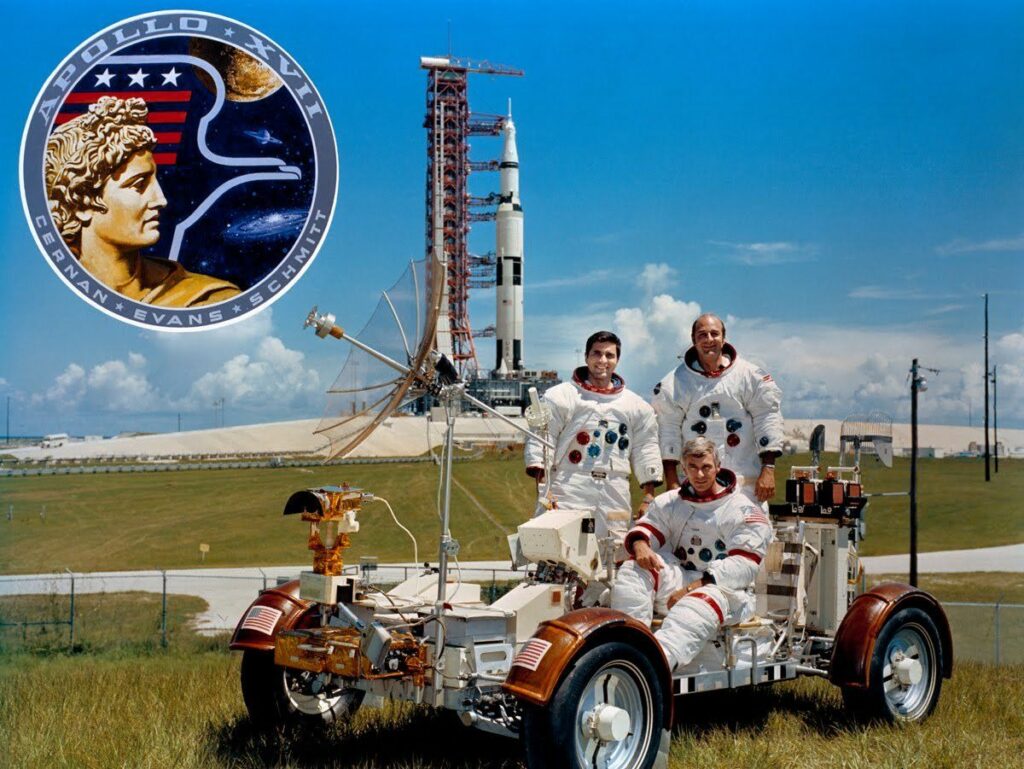
(C) Eugene A. Cernan, Commander
(R) Ronald E. Evans, Command Module Pilot
“I was naming the spacecraft like I’d name my baby.”
Apollo 17 was unique from other Apollo missions and broke several crewed spaceflight records which include the longest lunar landing and time in lunar orbit. Further Remarkable achievements are the highest total extravehicular activities and the number of largest lunar samples collected during the stay. It was crewed by Commander Eugene Cernan, Lunar Module Pilot Harrison Schmitt, and Command Module Pilot Ronald Evans.
The selected Landing site for Apollo 17 was located in mountainous highlands at the eastern rim of the Serenitatis basin, valley called Taurus-Littrow, a dark deposit between ridges of the southwestern Taurus Mountains and south of the crater Littrow. The valley floor is essentially flat with only a mild incline.
Major discoveries:
The Orange Soil
The discovery of an orange-colored soil on the Moon brought to much excitement and speculation. It included in the samples collected by the crew of Apollo 17 mission from Taurus-Littrow. First seen by the geologist among the crew the Harrison J. Schmitt at Shorty Crater, the fourth station of the second EVA. The orange particles were not pure rather intermixed with black and black-freckled grains. They were similar in size to the particles found in Earth’s slit.
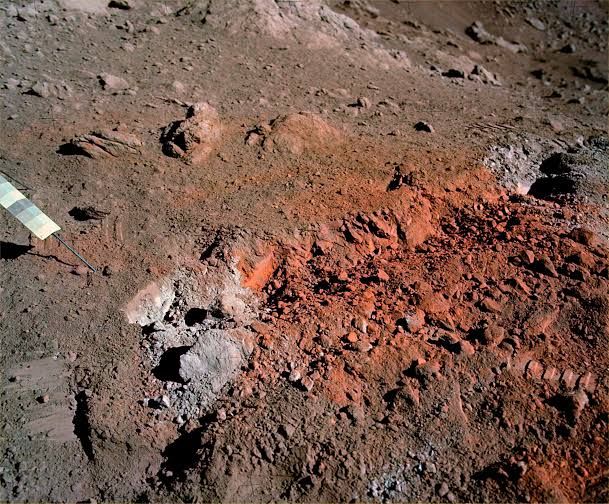
Further chemical analysis of the orange soil material depicts its similarity to the sample collected during Apollo 11 (Sea of Tranquility), as it was also rich in titanium (8%) and iron oxide (22%). But the remarkable difference from the Apollo 11 samples, it was unexplainably rich in zinc. It was thought to be originated from volcanos and not the product of meteorite obstructed. According to Jack Schmitt, hydrated iron oxides produces such yellow to orange coloration in Earth’s rocks. In a volcanic region, water-rich vapors reacting with the lavas and emanating from gas-vents or fumaroles, these minerals can produce.
The BLUE MARBLE SHOT:
Around five hours later after the launch, when the spacecraft had left the earth orbit and begun its course towards the moon, the three-man crew all started taking photographs with a 70mm Hasselblad camera fitted with an 80 mm Zeiss lens. By this time, they were approximately 29,000Km (18 Kilo miles) away from earth. This was far enough away from the entire planet to be seen through the spacecraft’s windows Since the onboard camera did not have a viewfinder it was necessary to take a sequence of photography with slightly different aim to ensure a successful image, because of this actual photograph was upside down with Antarctica at the top , but it still captured the entire globe from the Mediterranean Sea to the south polar ice cap.
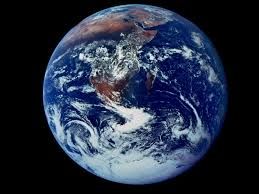
Subsequent analysis of the mission transcript suggests that lunar module pilot Harrison Jack Schmitt took the photograph, but NASA has always credited the whole crew while the astronauts themselves were also known to accept joint recognition.
Extravehicular activities (EVAs)
Extravehicular activity (EVA) refers to any activity performed by an astronaut or cosmonaut outside a spacecraft beyond the Earth’s appreciable atmosphere. Three extravehicular activities (EVAs) were conducted by the crew during their 75 hours on the Moon, totaling 22 hours on the lunar surface. These EVAs included lunar vagrant navigates totaling 36 kilometers, collection of lunar samples at 22 locations in the Taurus-Littrow Valley, deployment or performance of 10 science experiments, and examination and photography of the lunar surface.
First Extravehicular Activity
The first lunar surface EVA started on 11th December at 6:54 p.m. EST and lasted 7 hours and 12 minutes. ending at 2:06 a.m. EST on December 12th. Astronaut Eugene Cernan, commander of Apollo 17, salutes the deployed U.S. flag on the lunar surface. Deployment of the lunar rover and ALSEP (Apollo Lunar Surface Experiments Package) also proceeded during the first EVA.
The Geologic traverse shortened to a brief 3.5 km distance, then desired and planned length of the traverse to encounter with extra time required in the deployment of experiment package. Further activities include the collection of multiple lunar samples including a deep core tube, from the locality of the lunar module. The lunar rover checked by Cernan during the early part of the first EVA. Few minor difficulties like the accidental knocking off of the right rear fender during the first EVA and it must have to be repaired at the start of the second extravehicular activity, but the deployment of the lunar rover went successful.

Deployment of The Apollo Lunar Surface Experiments Package (ALSEP) proceeded at approximately 185 meters toward west-northwest of the lunar module during this EVA. The experiments package includes
- The Lunar Seismic Profiling Experiment
- Heat Flow Experiment
- Lunar Surface Gravimeter Experiment
- the Lunar Ejecta and Meteorites Experiment
- Lunar Atmospheric Composition Experiment.
Some additional activities include a collection of deep core sample and a Traverse Gravimeter Experiment measurement. For most of the part, all proceeding went normal except the few difficulties in leveling of antenna and central station and in the retrieval of drill cores. Several geological structures found near the landing sites and for their study and analysis, the gravitational acceleration at various stops along the traverses relative to the value of the gravitational acceleration at the landing site measured by the Traverse Gravimeter Experiment.
The geologic traverse comprised of a single station located about 150 meters from the northwest rim of Steno Crater, although this was originally planned for Emory Crater (About 2.5km) but shortened due to delay caused by the deployment of ALSEP and core holes drilling. Several samples of this subsurface material collected from this site. Activities at this site included deploying a total of eight explosive charges for the Lunar Seismic Profiling Experiment, measurement of traverse gravimeter, gathering of rake samples, and panoramic photography.
Second Extravehicular Activity
Toward the south and west of the landing site, the second EVA was a 20.4-kilometer geologic traverse which lasted 7 hours and 37 minutes. Total twelve sampling stops made including the four major and eight minor sampling stops. Accidentally a hammer got underneath the fender and a part of the fender was knocked off during the first EVA. Due to this broken fender, a dust plume kicks up by the rover while moving which caused difficulty for the crew. The crew repaired it at the beginning of EVA 2 by following the suggestions from astronaut John Young at Mission Control.
The Geologic Traverse comprised of the following five stations.
Station 2 – Nansen Crater located at the foot of South Massif near the southeast rim of Nansen Crater. A landslide in this region put boulders from high on the massif into the reach of the astronauts. A sampling of these boulders was the main objective of this stop as these were thought to be made of from material formed in the early stage of Moon’s history and that probably came from the Moon’s crust depth. In addition to sample collection, the astronauts also performed panoramic and documentary photography. The crew also made traverse gravimeter and some electrical properties measurements as well.
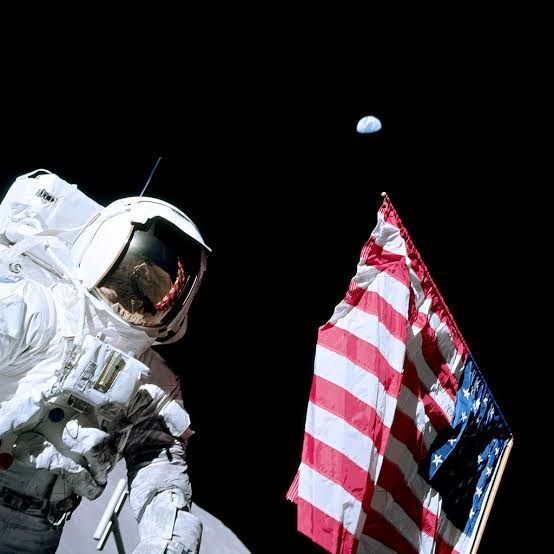
Station 2A located about 600 meters northeast of Nansen Crater, the major aim at this stop was to measure the additional traverse gravimeter in order to determine the gravity gradient present between the landing site and South Massif. In addition to this astronaut also gathered four of the rover as well.
Station 3 – Lara Crater located about 50 meters east of the rim of Lara Crater. Despite time limitations the crew took a traverse gravimeter measurement, gathered samples including a double-length core tube sample and a rake sample, and also performed panoramic and 500-millimeter photography.
Station 4 – Shorty Crater located on the south rim crest of Shorty Crater. Activities performed by the crew include electrical properties the traverse gravimeter and measurements; collection of various samples, including a trench sample and a double-length core tube sample; and performed documentary and panoramic photography. The main purpose behind the creation of this stop is to determine whether it is a volcanic structure or not. The famous “orange soil” was also discovered at this station which is thought to be an older volcanic deposit. Station 5 – Camelot Crater was located within a block field on the southwest rim of Camelot Crater. Traverse gravimeter measurement, documentary, sample gathering, and panoramic photography were performed at this location.
Third Extravehicular Activity
The 12.1-kilometer geologic traverse to the north and east region of the valley was the primary goal of the third EVA which lasted 7 hours and 15 minutes. Total eight sampling stops made, including four major and four minor stops. The major objective was to sample several large boulders near the base of the North Massif. These boulders had rolled down from high on the massif, as shown by the tracks along the massif. It allowed the crew to sample massif material that would otherwise have been inaccessible. The material in the North Massif was sampled in the expectation that it would contain elements that formed very early in the Moon’s history and deep in the crust. One additional stop, Station 10, had planned but later eliminated to allow more time for some unfinished mission tasks. The EVA ends December 14th, at 12:40 a.m.
The third EVA began with a stop at the Surface Electrical Properties Experiment site as with EVA 2. Experiments were activated by the crew but attempt to make additional measurements with this equipment during EVA 3 were unsuccessful. The Geologic Traverse comprised of four stations along with an additional LRV stop. Station 6 – North Massif located on the south slope of the North Massif, approximately 250 meters north of the break-in slope between the valley floor and the massif. The activities performed by the crew here includes a measurement of traverse gravimeter, samples collection and performed documentary, panoramic, and 500-millimeter photography. Station 7 – North Massif was on the base of the North Massif.
The crew collected samples, panoramic photography, and documentary at this site. Station 8 – Sculptured Hills was located near the base of the Sculptured Hills. The crew gathered several samples including rake and trench samples and two traverse gravimeter measurements were also included in the activities at this site. Station 9 – Van Serg Crater, last station on the geological traverse, numerous activities were performed at this location. Activities include deployment of explosive charge for the Lunar Seismic Profiling Experiment, two more traverse gravimeter measurements and Samples collection, including a trench sample and a double-length core tube sample. Documentary, panoramic, and 500-millimeter photography were also performed by the astronauts. Data storage electronic assembly from the Surface Electrical Properties Experiment receiver was removed at last.
During this EVA several additional tasks also performed by the astronauts, which include the recovery of the Lunar Surface Cosmic Ray Experiment plates, three additional traverse gravimeter measurements, more photographs were captured and deployment of the last two explosive charges for the Lunar Seismic Profiling Experiment, near the lunar module. The Lunar Neutron Probe Experiment was retrieved, and the lunar rover parked at Cochise Crater at the end of the EVA. As part of the final close-out, rock samples for distribution to other nations collected and a plaque commemorating the Apollo landings revealed. To obtain data on neutron capture rates in the lunar regolith as a function of depth the Lunar Neutron Probe Experiment Recovery was designed, and it deployed through the deep drill core of northwest side of the lunar module. At the end of EVA 3 after 49 hours of exposure, the 2-meter probe recovered and deactivated.
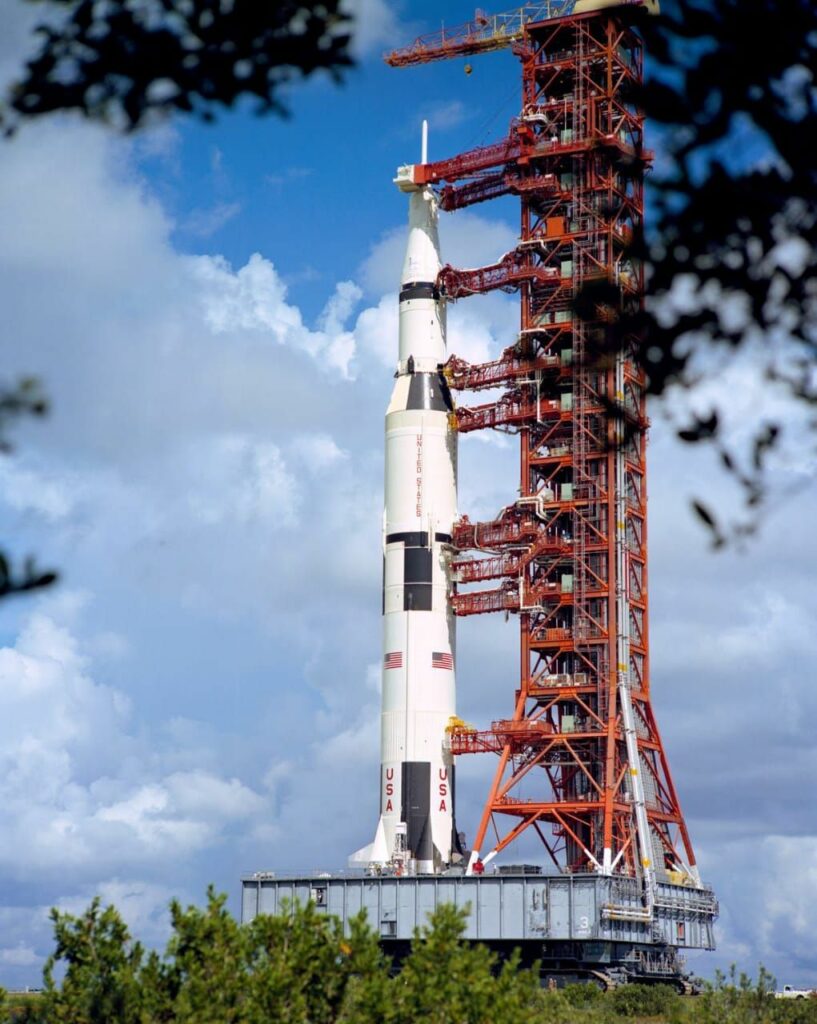
End of the Lunar missions
The journey of man for reaching out to the moon ended up with the last Apollo 17 mission but this was not the end of exploration. Man has shifted its attention and focus toward other space stations like MARS is the next big target for humankind. The scientific community got the huge collection of data which includes 741 individual rock and soil samples, a deep drill containing a total 111 kg of material obtained from 3 meters below the lunar surface from Apollo 17 mission.
This finding was sufficient to address and justified the major objectives of the mission. During the intensive exploration carried out by the Apollo missions, many questions remained to be addressed. Hopefully, they will get answers with future missions to the moon.

Iqra Bibi is BS BIOCHEMISTRY student at Quaid e Azam University. She is serving YOLO as an academic Secretary and Also part of the event management team of various non-profit organizations. She loves to write Urdu poetry and work for its promotion through her Youtube channel “Harf e Junoon”. Her hobbies include novels and book reading.

